The Traditional Medicine and Modern Medicine from Natural Products
Abstract
:1. Introduction
2. Natural Products
3. Traditional Medicines
4. Drugs Developed from Traditional Medicines that Follow the Traditional Uses
5. Drugs Developed from Natural Products
6. Discussion
Acknowledgments
Conflicts of Interest
References
- Shi, Q.W.; Li, L.G.; Huo, C.H.; Zhang, M.L.; Wang, Y.F. Study on natural medicinal chemistry and new drug development. Chin. Tradit. Herb. Drugs 2010, 41, 1583–1589. [Google Scholar]
- Fabricant, D.S.; Farnsworth, N.R. The Value of Plants Used in Traditional Medicine for Drug Discovery. Environ. Health Perspect. 2001, 109, 69–75. [Google Scholar] [CrossRef] [PubMed]
- Gao, X.M.; Zhang, T.M.; Zhang, J.R.; Guo, J.S.; Zhong, G.S. Chinese Materia Medica; China Press of traditional Chinese Medicine: Beijing, China, 2007. [Google Scholar]
- Alves, R.R.; Rosa, I.M. Biodiversity, traditional medicine and public health: Where do they meet? J. Ethnobiol. Ethnomed. 2007, 3. [Google Scholar] [CrossRef] [PubMed]
- Dong, J.C. The Relationship between Traditional Chinese Medicine and Modern Medicine. Evid. Based Complment. Altern. Med. 2013, 2013. [Google Scholar] [CrossRef] [PubMed]
- Zhang, L.H.; Li, J. Current situation and developing trends of modernization of traditional Chinese Medicine. J. Zhejiang Univ. Med. Sci. 2011, 40, 349–353. [Google Scholar]
- Chan, K.; Shaw, D.; Simmonds, M.S.; Leon, C.J.; Xu, Q.; Lu, A.; Sutherland, I.; Ignatova, S.; Zhu, Y.P.; Verpoorte, R.; et al. Good practice in reviewing and publishing studies on herbal medicine, with special emphasis on traditional Chinese medicine and Chinese materia medica. J. Ethnopharmacol. 2012, 140, 469–475. [Google Scholar] [CrossRef] [PubMed]
- Tu, P.F.; Guo, H.Z.; Guo, D.A. Researches on active constituents of natural and traditional medicine and development of new drugs. J. Peking Univ. Health Sci. 2002, 34, 513–518. [Google Scholar]
- Zhang, L.; Yan, J.; Liu, X.; Ye, Z.; Yang, X.; Meyboom, R.; Chan, K.; Shaw, D.; Duez, P. Pharmacovigilance practice and risk control of Traditional Chinese Medicine drugs in China: Current status and future perspective. J. Ethnopharmacol. 2012, 140, 519–525. [Google Scholar] [CrossRef] [PubMed]
- Joo, Y.E. Natural product-derived drugs for the treatment of inflammatory bowel diseases. Intest. Res. 2014, 12, 103–109. [Google Scholar] [CrossRef] [PubMed]
- Hamilton, G.R.; Baskett, T.F. In the arms of Morpheus the development of morphine for postoperative pain relief. Can. J. Anaesth. 2000, 47, 367–374. [Google Scholar] [CrossRef] [PubMed]
- Newman, D.J.; Cragg, G.M.; Snader, K.M. Natural Products as Sources of New Drugs over the Period 1981–2002. J. Nat. Prod. 2003, 66, 1022–1037. [Google Scholar] [CrossRef] [PubMed]
- Ngo, L.T.; Okogun, J.I.; Folk, W.R. 21st Century natural product research and drug development and traditional medicines. Nat. Prod. Rep. 2013, 30, 584–592. [Google Scholar] [CrossRef] [PubMed]
- Zhu, F.; Ma, X.H.; Qin, C.; Tao, L.; Liu, X.; Shi, Z.; Zhang, C.L.; Tan, C.Y.; Chen, Y.Z.; Jiang, Y.Y. Drug discovery prospect from untapped species: Indications from approved natural product drugs. PLoS ONE 2012, 7, e39782. [Google Scholar] [CrossRef] [PubMed]
- Galm, U.; Shen, B. Natural product drug discovery: The times have never been better. Chem. Biol. 2007, 14, 1098–1104. [Google Scholar] [CrossRef] [PubMed]
- Hong, J.Y. Natural product diversity and its role in chemical biology and drug discovery. Curr. Opin. Chem. Biol. 2011, 15, 350–354. [Google Scholar] [CrossRef] [PubMed]
- Rosén, J.; Gottfries, J.; Muresan, S.; Backlund, A.; Oprea, T.I. Novel chemical space exploration via natural products. J. Med. Chem. 2009, 52, 1953–1962. [Google Scholar] [CrossRef] [PubMed]
- Butler, M.S. Natural products to drugs: Natural product-derived compounds in clinical trials. Nat. Prod. Rep. 2008, 25, 475–516. [Google Scholar] [CrossRef] [PubMed]
- Muschietti, L.; Vila, R.; Filho, V.C.; Setzer, W. Tropical Protozoan Diseases: Natural Product Drug Discovery and Development. Evid. Based Complement. Altern. Med. 2013, 2013. [Google Scholar] [CrossRef] [PubMed]
- Cragg, G.M.; Newman, D.J. Natural products: A continuing source of novel drug leads. Biochim. Biophys. Acta 2013, 1830, 3670–3695. [Google Scholar] [CrossRef] [PubMed]
- Li-Weber, M. New therapeutic aspects of flavones: The anticancer properties of Scutellaria and its main active constituents Wogonin, Baicalein and Baicalin. Cancer Treat. Rev. 2009, 35, 57–68. [Google Scholar] [CrossRef] [PubMed]
- Winter, J.M.; Tang, Y. Synthetic biological approaches to natural product biosynthesis. Curr. Opin. Biotechnol. 2012, 23, 736–743. [Google Scholar] [CrossRef] [PubMed]
- Li, J.W.; Vederas, J.C. Drug discovery and natural products: End of an era or an endless frontier? Science 2009, 325, 161–165. [Google Scholar] [CrossRef] [PubMed]
- Abdullahi, A.A. Trends and challenges of traditional medicine in Africa. Afr. J. Tradit. Complement. Altern. Med. 2011, 8, 115–123. [Google Scholar] [CrossRef] [PubMed]
- World Health Organisation. General Guidelines for Methodologies on Research and Evaluation of Traditional Medicine; World Health Organisation: Geneva, Switzerland, 2000. [Google Scholar]
- Qi, F.H.; Wang, Z.X.; Cai, P.P.; Zhao, L.; Gao, J.J.; Kokudo, N.; Li, A.Y.; Han, J.Q.; Tang, W. Traditional Chinese medicine and related active compounds: A review of their role on hepatitis B virus infection. Drug Discov. Ther. 2013, 7, 212–224. [Google Scholar] [CrossRef] [PubMed]
- Dobos, G.J.; Tan, L.; Cohen, M.H.; McIntyre, M.; Bauer, R.; Li, X.; Bensoussan, A. Are national quality standards for traditional Chinese herbal medicine sufficient? Current governmental regulations for traditional Chinese herbal medicine in certain Western countries and China as the Eastern origin country. Complement. Ther. Med. 2005, 13, 183–190. [Google Scholar] [CrossRef] [PubMed]
- Zhang, A.H.; Sun, H.; Qiu, S.; Wang, X.J. Advancing drug discovery and development from active constituents of yinchenhao tang, a famous traditional Chinese medicine formula. Evid. Based Complement. Altern. Med. 2013, 2013. [Google Scholar] [CrossRef] [PubMed]
- Watanabe, S.; Imanishi, J.; Satoh, M.; Ozasa, K. Unique place of Kampo (Japanese traditional medicine) in complementary and alternative medicine: A survey of doctors belonging to the regional medical association in Japan. Tohoku J. Exp. Med. 2001, 194, 55–63. [Google Scholar] [CrossRef] [PubMed]
- Yakubo, S.; Ito, M.; Ueda, Y.; Okamoto, H.; Kimura, Y.; Amano, Y.; Togo, T.; Adachi, H.; Mitsuma, T.; Watanabe, K. Pattern classification in kampo medicine. Evid. Based Complement. Altern. Med. 2014, 2014. [Google Scholar] [CrossRef] [PubMed]
- Mogami, S.; Hattori, T. Beneficial effects of rikkunshito, a Japanese kampo medicine, on gastrointestinal dysfunction and anorexia in combination with Western drug: A systematic review. Evid. Based Complement. Altern. Med. 2014, 2014. [Google Scholar] [CrossRef] [PubMed]
- Yu, F.; Takahashi, T.; Moriya, J.; Kawaura, K.; Yamakawa, J.; Kusaka, K.; Itoh, T.; Morimoto, S.; Yamaguchi, N.; Kanda, T. Traditional Chinese medicine and Kampo: A review from the distant past for the future. J. Int. Med. Res. 2006, 34, 231–239. [Google Scholar] [CrossRef] [PubMed]
- Lone, A.H.; Ahmad, T.; Anwar, M.; Sofi, G.; Imam, H.; Habib, S. Perception of health promotion in Unani herbal medicine. J. Herb. Med. 2012, 2. [Google Scholar] [CrossRef]
- Jabin, F. A guiding tool in Unani Tibb for maintenance and preservation of health: A review study. Afr. J. Tradit. Complement. Altern. Med. 2011, 8, 140–143. [Google Scholar] [CrossRef] [PubMed]
- Parasuraman, S.; Thing, G.S.; Dhanaraj, S.A. Polyherbal formation: Concept of ayurveda. Pharmacogn. Rev. 2014, 8, 73–80. [Google Scholar] [CrossRef] [PubMed]
- Lu, M. Status and Trends of Chinese Traditional Medicine Industry. Chin. J. Pharm. Ind. 2013, 44, 214–216. [Google Scholar]
- Boakye, M.K.; Pietersen, D.W.; Kotzé, A.; Dalton, D.L.; Jansen, R. Knowledge and uses of African pangolins as a source of traditional medicine in Ghana. PLoS ONE 2015, 10, e0117199. [Google Scholar] [CrossRef] [PubMed]
- Oliver, S.J. The role of traditional medicine practice in primary health care within Aboriginal Australia: A review of the literature. J. Ethnobiol. Ethnomed. 2013, 9. [Google Scholar] [CrossRef] [PubMed]
- Lev, E. Ethno-diversity within current ethno-pharmacology as part of Israeli traditional medicine--a review. J. Ethnobiol. Ethnomed. 2006. [Google Scholar] [CrossRef]
- Brief Introduction of Huang Di Nei Jing. Available online: http://www.cssn.cn/sjxz/xsjdk/zgjd/zb/yj/ hdnjw/201503/ t20 150328_1564689. shtml (accessed on 28 April 2015).
- Lehmann, H. A Westerner’s question about traditional Chinese medicine: Are the Yinyang concept and the Wuxing concept of equal philosophical and medical rank? J. Chin. Integr. Med. 2012, 10, 237–248. [Google Scholar] [CrossRef]
- World Health Organization. WHO Traditional Medicine Strategy: 2014–2023; World Health Organization: Geneva, Switzerland, 2013. [Google Scholar]
- Xue, R.; Fang, Z.; Zhang, M.; Yi, Z.; Wen, C.; Shi, T. TCMID: Traditional Chinese Medicine integrative database for herb molecular mechanism analysis. Nucleic Acids Res. 2013. [Google Scholar] [CrossRef] [PubMed]
- Patwardhan, B. Bridging Ayurveda with evidence-based scientific approaches in medicine. EPMA J. 2014. [Google Scholar] [CrossRef] [PubMed]
- Hongal, S.; Torwane, N.A.; Pankaj, G.; Chandrashekhar, B.R.; Gouraha, A. Role of unani system of medicine in management of orofacial diseases: A review. J. Clin. Diagn. Res. 2014, 8, ZE12–ZE15. [Google Scholar] [PubMed]
- Govindasamy, C.; Kannan, R. Pharmacognosy of mangrove plants in the system of Unani medicine. Asia Pac. J. Trop. Dis. 2012, 2, S38–S41. [Google Scholar] [CrossRef]
- Okamoto, H.; Iyo, M.; Ueda, K.; Han, C.; Hirasaki, Y.; Namiki, T. Yokukan-san: A review of the evidence for use of this Kampo herbal formula in dementia and psychiatric conditions. Neuropsychiatr. Dis. Treat. 2014. [Google Scholar] [CrossRef] [PubMed]
- Kim, J.U.; Ku, B.; Kim, Y.M.; Do, J.H.; Jang, J.S.; Jang, E.; Jeon, Y.J.; Kim, K.H.; Kim, J.Y. The concept of sasang health index and constitution-based health assessment: An integrative model with computerized four diagnosis methods. Evid. Based Complement. Altern. Med. 2013. [Google Scholar] [CrossRef] [PubMed]
- Yoon, D.W.; Lee, S.K.; Yi, H.; Hong, J.H.; Soichiro, M.; Lee, S.W.; Kim, J.Y.; Shin, C. Total nasal resistance among Sasang constitutional types: A population-based study in Korea. BMC Complement. Altern. Med. 2013. [Google Scholar] [CrossRef] [PubMed]
- Kim, J.Y.; Noble, D. Recent progress and prospects in Sasang constitutional medicine: A traditional type of physiome-based treatment. Prog. Biophys. Mol. Biol. 2014, 116, 76–80. [Google Scholar] [CrossRef] [PubMed]
- Wintola, O.A.; Afolayan, A.J. The antibacterial, phytochemicals and antioxidants evaluation of the root extracts of Hydnora africana Thunb. used as antidysenteric in Eastern Cape Province, South Africa. BMC Complement. Altern. Med. 2015. [Google Scholar] [CrossRef]
- Shikov, A.N.; Pozharitskaya, O.N.; Makarov, V.G.; Wagner, H.; Verpoorte, R.; Heinrich, M. Medicinal plants of the Russian Pharmacopoeia; their history and applications. J. Ethnopharmacol. 2014, 154, 481–536. [Google Scholar] [CrossRef] [PubMed]
- Zhao, S.X.; Ye, W.C.; Gu, J.H.; Liu, J.H.; Zhang, X.Q.; Yin, Z.Q.; Wang, H.; Zhang, L.H.; Guo, Y.Z.; Feng, J.X. Medicinal plant resources in Lingnan area and emergency medicine in Ge Hong zhou hou bei ji fang. Asia Pac. Tradit. Med. 2012, 8, 11–12. [Google Scholar]
- Li, J.; Zhou, B. Biological actions of artemisinin: Insights from medicinal chemistry studies. Molecules 2010, 15, 1378–1397. [Google Scholar] [CrossRef] [PubMed]
- Li, Y. Qinghaosu (artemisinin): Chemistry and pharmacology. Acta Pharmacol. Sin. 2012, 33, 1141–1146. [Google Scholar] [CrossRef] [PubMed]
- Wu, Y.L. Artemisinin --the revelation of the history and reality. Chemical Progress. Chem. Prog. 2009, 21, 2365–2371. [Google Scholar]
- Yang, Y.F.; Yang, B.C.; Jin, L.L. Retrospection, strategy, and practice on innovative drug research and development of Chinese materia medica. Chin. Tradit. Herb. Drugs 2009, 40, 1513–1519. [Google Scholar]
- Xu, T.; Jin, X.L.; Cao, H.M. Research progress of pharmacological effects of tetrahydropalmatine. Chin. J. Clin. Pharm. 2001, 10, 58–60. [Google Scholar]
- Jiang, H.B.; Wang, J.; Su, J.H.; Fang, M.M.; Yang, N.; Yang, J.W.; Wang, F.; Xiao, H.; Tang, J.R. Effect of tetrahydropalmatine on expression of Cav1.2 dorsal root ganglion neurons in mice with sciatic nerve chronic constriction injury.Chinese Pharmacological Bulletin. Chin. Pharm. Bull. 2015, 31, 1598–1603. [Google Scholar]
- Qian, W.; Xiong, X.; Fang, Z.; Lu, H.; Wang, Z. Protective effect of tetramethylpyrazine on myocardial ischemia-reperfusion injury. Evid. Based Complement. Altern. Med. 2014, 2014. [Google Scholar] [CrossRef] [PubMed]
- Zhang, X.J.; Chen, H.L.; Li, Z.; Zhang, H.Q.; Xu, H.X.; Sung, J.J.; Bian, Z.X. Analgesic effect of paeoniflorin in rats with neonatal maternal separation-induced visceral hyperalgesia is mediated through adenosine A(1) receptor by inhibiting the extracellular signal-regulated protein kinase (ERK) pathway. Pharmacol. Biochem. Behav. 2009, 94, 88–97. [Google Scholar] [CrossRef] [PubMed]
- Ge, Y.B.; Cheng, X.Z.; Yan, A.L.; Xu, J. Research progress of anti-tumor mechanism of paeoniflorin. Journal of Chinese Medicinal Materials. J. Chin. Med. Mater. 2015, 38, 636–639. [Google Scholar]
- Zhao, P.W.; Niu, J.Z.; Lee, D.Y.; Wang, J.F.; Sun, Y.L.; Li, Y.D. Effect and mechanism of traditional Chinese medicine and their active constituents in postmenopausal osteoporosis. China Journal of Chinese Materia Medica. Chin. J. Chin. Mater. Med. 2012, 37, 1693–1698. [Google Scholar]
- Wang, X.M. Progress of pharmacological research on icariin. Chin. J. Chin. Mater. Med. 2008, 33, 2727–2732. [Google Scholar]
- Zhong, Y.; Zhang, X.; Cai, X.; Wang, K.; Chen, Y.; Deng, Y. Puerarin attenuated early diabetic kidney injury through down-regulation of matrix metalloproteinase 9 in streptozotocin-induced diabetic rats. PLoS ONE 2014, 9, e85690. [Google Scholar] [CrossRef] [PubMed]
- Ma, C.; Yao, Y.; Yue, Q.X.; Zhou, X.W.; Yang, P.Y.; Wu, W.Y.; Guan, S.H.; Jiang, B.H.; Yang, M.; Liu, X.; et al. Differential proteomic analysis of platelets suggested possible signal cascades network in platelets treated with salvianolic acid B. PLoS ONE 2011, 6, e14692. [Google Scholar] [CrossRef] [PubMed]
- Lou, Z.; Peng, J. The Advance in Research on the Cardiovascular Protective Effects of Magnesium Lithospermate B and the underlying mechanisms. Chin. J. Arterioscler. 2013, 21, 855–858. [Google Scholar]
- Zhang, L.X.; Sun, T.; Cao, Y.X. Effects of Rhynchophylline on lowering blood pressure and diastolic blood vessel. Pharm. Clin. Res. Chin. Mater. Med. 2010, 26, 39–41. [Google Scholar]
- Wei, H.; Peng, Y.; Ma, G.X.; Xu, L.J.; Xiao, P.G. Advances in studies on active components of Saussurea lappa and their pharmacological actions. Chin. Tradit. Herb. Drugs 2012, 43, 613–620. [Google Scholar]
- Gong, Q.H.; Shi, J.S.; Yang, D.L.; Huang, B.; Xie, X.L. Pharmacological action and its mechanism of gastrodin in central nervous system. Chin. J. New Drugs Clin. Rem. 2011, 30, 176–179. [Google Scholar]
- Gong, D.H.; Zheng, W.H.; Luo, N.; Tang, G.C. Effects and the mechanism of gastrodin on chemotherapy- induced neuropathic pain through the expression of Ibal of spinal dorsal horn. Chin. J. Chin. Pharmacol. Ther. 2014, 19, 743–746. [Google Scholar]
- Liu, G.T.; Zhang, C.Z.; Li, Y. Study of the anti-hepatitis new drug bicyclol. Med. Res. J. 2010, 39. [Google Scholar] [CrossRef]
- Sun, H.; Yu, L.; Wei, H.; Liu, G. A novel antihepatitis drug, bicyclol, prevents liver carcinogenesis in diethylnitrosamine-initiated and phenobarbital-promoted mice tumor model. J. Biomed. Biotechnol. 2012, 2012. [Google Scholar] [CrossRef] [PubMed]
- Li, M.; Liu, G.T. Inhibition of Fas/FasL mRNA expression and TNF-α release in concanavalin A-induced liver injury in mice by bicyclol. World J. Gastroenterol. 2004, 10, 1775–1779. [Google Scholar] [CrossRef] [PubMed]
- Bao, X.Q.; Liu, G.T. Bicyclol: A novel antihepatitis drug with hepatic heat shock protein 27/70-inducing activity and cytoprotective effects in mice. Cell Stress Chaperones. Cell Stress Chaperones 2008, 13, 347–355. [Google Scholar] [CrossRef] [PubMed]
- Li, Y.T.; Du, L.P.; Mei, D. Progress in the study on the pharmacokinetics of Bicyclol. Med. Res. J. Med. Res. J. 2011, 40, 18–20. [Google Scholar]
- Wani, M.C.; Horwitz, S.B. Nature as a remarkable chemist: A personal story of the discovery and development of Taxol. Anticancer Drugs 2014, 25, 482–487. [Google Scholar] [CrossRef] [PubMed]
- Shi, W.Q.; Zhao, D.; Liu, S.Y. A review on studies and development of natural drug Taxol. Nat. Prod. Res. Dev. 1997, 9, 102–108. [Google Scholar]
- Holmes, F.A.; Walters, R.S.; Theriault, R.L.; Forman, A.D.; Newton, L.K.; Raber, M.N.; Buzdar, A.U.; Frye, D.K.; Hortobagyi, G.N. Phase II trial of taxol, an active drug in the treatment of metastatic breast cancer. J. Natl. Cancer Inst. 1991, 83, 1797–805. [Google Scholar] [CrossRef] [PubMed]
- Jing, L.L.; Jin, Y.; Zhang, S.Y.; Sun, X.L. Synthesis of anticancer drug docetaxel. Chin. J. Med. Chem. 2006, 16, 292–295. [Google Scholar]
- Faseleh Jahromi, M.; Liang, J.B.; Ho, Y.W.; Mohamad, R.; Goh, Y.M.; Shokryazdan, P. Lovastatin in Aspergillus terreus: Fermented rice straw extracts interfeRes. with methane production and gene expression in Methanobrevibacter smithii. Chin. J. Biomed. Res. Int. 2013, 2013. [Google Scholar] [CrossRef]
- Yang, P.F.; Chen, W.D. Research progress of pharmacological effects of gingolide B. J. Anhui TCM Univ. 2012, 31, 86–90. [Google Scholar]
- Han, F.; Jing, Z.W.; Yu, Y.N.; Liu, Y.N.; Liu, J.; Wang, Z. Process on Experimental Studies of Active Ingredients of Traditional Chinese Medicine for Vascular Dementia. Chin. J. Exp. Tradit. Med. Form. 2012, 18, 273–276. [Google Scholar]
- Li, S.Y.; Ji, X.Y.; Li, Z.R. The research progress of effective ingredients of traditional Chinese medicine against tuberculosis. Chin. J. Antibiot. 2013, 38, 725–729. [Google Scholar]
- Ji, X.Y.; Li, S.Y.; Meng, S.; Xiao, C.L.; You, X.F.; Li, Z.R. Synthesis and antimycobacterial activity of ternatolide. J. Chin. Pharm. Sci. 2012, 21, 265–268. [Google Scholar] [CrossRef]
- Fu, X.H.; Lin, L.M. Pharmacological research progress of main effective components of Curcuma longa L. J. Hubei Univ. Chin. Med. 2015, 17, 109–110. [Google Scholar]
- Yuan, C.L.; Sun, L.; Yuan, S.T.; Kou, J.P.; Yu, B.Y. Pharmacological activities and possible mechanism of effective components in Ophiopogonis radix. Chin. J. New Drug 2013, 22, 2496–2502. [Google Scholar]
- VanderMolen, K.M.; McCulloch, W.; Pearce, C.J.; Oberlies, N.H. Romidepsin (Istodax®, NSC 630176, FR901228, FK228, Depsipeptide): A Natural Product Recently Approved for Cutaneous T-cell Lymphoma. J. Antibiot. 2011, 64, 525–531. [Google Scholar] [CrossRef] [PubMed]
- Yang, X.W. Historical changes in the development of natural medicinal chemistry. J. Peking Univ. Health Sci. 2004, 36, 9–11. [Google Scholar]
| Name | Origin and Developing Nation | Characteristics of Theory or Application | Current Role or Status | Modern Research |
|---|---|---|---|---|
| Traditional Chinese medicine (TCM) [26,28,40,41,42,43] |
|
|
|
|
| Ayurveda [35,44] |
|
|
|
|
| Unani medicine [33,34,45,46] |
|
|
|
|
| Kampo (traditional Japanese medicine) [30,47] |
|
|
|
|
| Traditional Korean medicine (TKM), Sasang constitutional medicine (SCM) [42,48,49,50] |
|
|
|
|
| Traditional Aboriginal medicine [38,50] |
|
|
| |
| Traditional medicine in Africa [25,37,38,51] |
|
|
|
|
| Russian herbal medicine [52] |
|
|
|
|
| Plant Origin | Drugs or Compounds | Chemical Structures | Effects or Indications | Ancient Chinese Literature Recording Chinese Herbal Medicines with Same Effects and the Published Time |
|---|---|---|---|---|
| Artemisia annua L. [53,55] | Artemisinin |  | Anti-malarial | Zhou Hou Bei Ji Fang (Jin Danasty, AD 266–420) |
| Corydalis yanhusuo W.T.Wang [58,59] | Tetrahydropalmatine |  | Analgesic | Lei Gong Pao Zhi Lun (Nanchao Song Dynasty, AD 420–479) |
| Ligusticum chuanxiong Hort. [60] | Tetramethyl-pyrazine |  | Mmyocardial ischemia-reperfusion injury | Shen Nong Ben Cao Jing (Donghan Dynasty, AD 25–220) |
| Paeonia lactiflora Pall. [61,62] | Paeoniflorin | 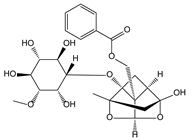 | Analgesic | Shen Nong Ben Cao Jing (Donghan Dynasty, AD 25–220) |
| Epimedium brevicornum Maxim. [63,64] | Icariin |  | Osteoporosis | Shen Nong Ben Cao Jing (Donghan Dynasty, AD 25–220) |
| Pueraria lobata (Willd.) Ohwi [65] | Puerarin | 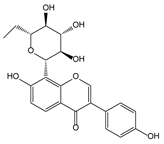 | Diabetes | Shen Nong Ben Cao Jing (Donghan Dynasty, AD 25–220) |
| Salvia miltiorrhiza Bunge [66,67] | Salvianolic acid B | 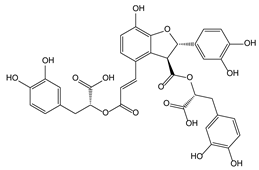 | Cardiovascular and cerebrovascular diseases | Shen Nong Ben Cao Jing (Donghan Dynasty, AD 25–220) |
| Uncaria rhynchophylla (Miq.) Jacks. [68] | Rhynchophy-lline |  | Antihypertensive | Ming Yi Bie Lu (Nanchao Liang Dynasty, AD 502–557) |
| Saussurea lappa (Decne.) C.B. Clarke [69] | Costunolide |  | Anti-gastric ulcer, antispasmodic | Shen Nong Ben Cao Jing (Donghan Dynasty, AD 25–220) |
| Gastrodia dlata Bl. [70,71] | Gastrodin |  | Anti-convulsion, analgesic | Shen Nong Ben Cao Jing (Donghan Dynasty, AD 25–220) |
| Origin (Plant, etc.) | Drugs or Compounds | Chemical Structures | Effects or Indication |
|---|---|---|---|
| Schisandra chinensis (Turcz.) Baill. [55,72,73,74,75,76] | Schisandrin C, bicyclol, bifendate | 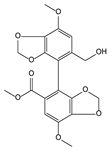 | Hepatoprotective, anti-hepatitis B virus |
| bicyclol | |||
| Taxus brevifolia [77,78,79,80] | Taxol, docetaxel | 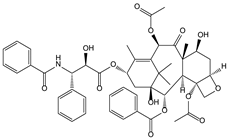 | Antitumor |
| taxol | |||
| Aspergillus terreus [81] | Lovastatin |  | Hyperlipoidemia |
| Camptotheca acuminata Decne. [1] | Camptothecin, irinotecan and topotecan | 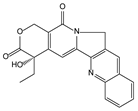 | Antitumor |
| camptothecin | |||
| Gimkgo biloba L. [82] | Ginkgolide B | 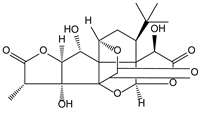 | Cerebral infarction |
| Polygonum multiflorum Thunb. [83] | Stilbene glycoside | 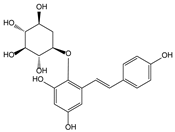 | Vascular dementia |
| Ranunculus ternatus hunb. [84,85] | Ternatolide |  | Anti-tuberculosis |
| Curcuma longa L. [86] | Curcumin |  | Hypolipidemic |
| Ophiopogon japonicus (L.f.) Ker-Gawl. [87] | Polysaccharide MDG-1 | 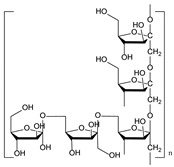 | Anti-myocardial cell injury |
| Chromobacterium violaceum [88] | Romidepsin | 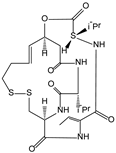 | Antitumor |
© 2016 by the authors. Licensee MDPI, Basel, Switzerland. This article is an open access article distributed under the terms and conditions of the Creative Commons Attribution (CC-BY) license ( http://creativecommons.org/licenses/by/4.0/).
Share and Cite
Yuan, H.; Ma, Q.; Ye, L.; Piao, G. The Traditional Medicine and Modern Medicine from Natural Products. Molecules 2016, 21, 559. https://doi.org/10.3390/molecules21050559
Yuan H, Ma Q, Ye L, Piao G. The Traditional Medicine and Modern Medicine from Natural Products. Molecules. 2016; 21(5):559. https://doi.org/10.3390/molecules21050559
Chicago/Turabian StyleYuan, Haidan, Qianqian Ma, Li Ye, and Guangchun Piao. 2016. "The Traditional Medicine and Modern Medicine from Natural Products" Molecules 21, no. 5: 559. https://doi.org/10.3390/molecules21050559
APA StyleYuan, H., Ma, Q., Ye, L., & Piao, G. (2016). The Traditional Medicine and Modern Medicine from Natural Products. Molecules, 21(5), 559. https://doi.org/10.3390/molecules21050559





